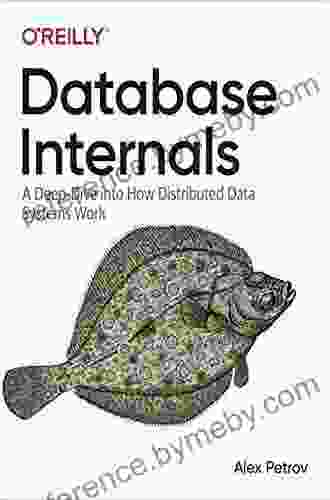Deep Dive Into How Distributed Data Systems Work

Distributed data systems are becoming increasingly popular as businesses need to manage and process large amounts of data. These systems allow data to be stored and processed across multiple computers, which can provide benefits such as scalability, performance, and reliability.
4.7 out of 5
| Language | : | English |
| File size | : | 12294 KB |
| Text-to-Speech | : | Enabled |
| Screen Reader | : | Supported |
| Enhanced typesetting | : | Enabled |
| Print length | : | 598 pages |
However, designing and implementing distributed data systems can be complex. There are a number of challenges that need to be addressed, such as data partitioning, replication, consistency, and fault tolerance.
This book provides a comprehensive overview of the design and implementation of distributed data systems. It covers a wide range of topics, including:
* Data partitioning * Replication * Consistency * Fault tolerance * Performance optimization * Security
Data Partitioning
Data partitioning is the process of dividing data into smaller pieces that can be stored on different computers. This can improve performance by reducing the amount of data that needs to be transferred between computers.
There are a number of different ways to partition data, such as:
* Horizontal partitioning: This involves dividing data into rows. For example, a customer table could be partitioned by customer ID. * Vertical partitioning: This involves dividing data into columns. For example, a customer table could be partitioned by customer name, address, and phone number. * Range partitioning: This involves dividing data into ranges of values. For example, a customer table could be partitioned by customer age.
The choice of partitioning strategy depends on the specific requirements of the application.
Replication
Replication is the process of storing multiple copies of data on different computers. This can improve performance by reducing the latency of data access. It can also improve reliability by ensuring that data is still available even if one or more computers fail.
There are a number of different replication strategies, such as:
* Full replication: This involves storing a complete copy of the data on every computer. * Partial replication: This involves storing only a subset of the data on each computer. * Asynchronous replication: This involves replicating data without waiting for confirmation from the receiving computer. * Synchronous replication: This involves replicating data and waiting for confirmation from the receiving computer before proceeding.
The choice of replication strategy depends on the specific requirements of the application.
Consistency
Consistency is the property of ensuring that data is always consistent across all copies. This can be a challenge in a distributed system, where data is constantly being updated.
There are a number of different consistency models, such as:
* Strong consistency: This ensures that all copies of data are always consistent. * Weak consistency: This allows for some inconsistencies between copies of data. * Eventual consistency: This ensures that all copies of data will eventually become consistent.
The choice of consistency model depends on the specific requirements of the application.
Fault Tolerance
Fault tolerance is the ability of a system to continue operating even if one or more computers fail. This can be achieved through a variety of techniques, such as:
* Redundancy: This involves storing multiple copies of data on different computers. * Failover: This involves automatically switching to a backup computer if the primary computer fails. * Load balancing: This involves distributing data and processing across multiple computers to reduce the impact of a single computer failure.
The choice of fault tolerance techniques depends on the specific requirements of the application.
Performance Optimization
Performance optimization is the process of improving the performance of a distributed data system. There are a number of different techniques that can be used to improve performance, such as:
* Caching: This involves storing frequently accessed data in memory to reduce the latency of data access. * Indexing: This involves creating indexes on data to speed up data retrieval. * Query optimization: This involves optimizing queries to reduce the amount of time it takes to execute them. * Sharding: This involves dividing data into smaller pieces that can be processed independently.
The choice of performance optimization techniques depends on the specific requirements of the application.
Security
Security is a critical consideration for any distributed data system. There are a number of different security measures that can be implemented, such as:
* Encryption: This involves encrypting data to protect it from unauthorized access. * Authentication: This involves verifying the identity of users before they are granted access to data. * Authorization: This involves controlling which users have access to which data. * Auditing: This involves tracking user activity to detect and prevent unauthorized access to data.
The choice of security measures depends on the specific requirements of the application.
Distributed data systems are playing an increasingly important role in businesses today. This book has provided a comprehensive overview of the design and implementation of distributed data systems. It has covered a wide range of topics, including data partitioning, replication, consistency, fault tolerance, performance optimization, and security.
By understanding the concepts presented in this book, you can design and implement distributed data systems that are scalable, performant, and reliable.
4.7 out of 5
| Language | : | English |
| File size | : | 12294 KB |
| Text-to-Speech | : | Enabled |
| Screen Reader | : | Supported |
| Enhanced typesetting | : | Enabled |
| Print length | : | 598 pages |
Do you want to contribute by writing guest posts on this blog?
Please contact us and send us a resume of previous articles that you have written.
 Book
Book Novel
Novel Page
Page Chapter
Chapter Text
Text Story
Story Genre
Genre Reader
Reader Library
Library Paperback
Paperback E-book
E-book Magazine
Magazine Newspaper
Newspaper Paragraph
Paragraph Sentence
Sentence Bookmark
Bookmark Shelf
Shelf Glossary
Glossary Bibliography
Bibliography Foreword
Foreword Preface
Preface Synopsis
Synopsis Annotation
Annotation Footnote
Footnote Manuscript
Manuscript Scroll
Scroll Codex
Codex Tome
Tome Bestseller
Bestseller Classics
Classics Library card
Library card Narrative
Narrative Biography
Biography Autobiography
Autobiography Memoir
Memoir Reference
Reference Encyclopedia
Encyclopedia Sheryl Peterson
Sheryl Peterson Afrodite Rossini
Afrodite Rossini Suzanne Ostersmith
Suzanne Ostersmith Carol Dulis
Carol Dulis Alan E Beer
Alan E Beer Kenneth D Weiss
Kenneth D Weiss Adam Von Romer Ccim
Adam Von Romer Ccim Adrian Wojnarowski
Adrian Wojnarowski Don Tapscott
Don Tapscott Agnes Kamara Umunna
Agnes Kamara Umunna Alberto Manguel
Alberto Manguel Mack Wiebe
Mack Wiebe Adams Media
Adams Media Adam Parkinson
Adam Parkinson Alex Hutchinson
Alex Hutchinson Alan Revolti
Alan Revolti Aimi Aikawa
Aimi Aikawa Eoin Mclaughlin
Eoin Mclaughlin Andrew Nahum
Andrew Nahum Siena Castellon
Siena Castellon
Light bulbAdvertise smarter! Our strategic ad space ensures maximum exposure. Reserve your spot today!

 Timothy WardGladiators: Legendary Warriors by Adrienne Lee - Uncover the Epic World of...
Timothy WardGladiators: Legendary Warriors by Adrienne Lee - Uncover the Epic World of... Jayson PowellFollow ·5k
Jayson PowellFollow ·5k Derrick HughesFollow ·14.9k
Derrick HughesFollow ·14.9k Benjamin StoneFollow ·3.6k
Benjamin StoneFollow ·3.6k Bryan GrayFollow ·17k
Bryan GrayFollow ·17k Edgar Allan PoeFollow ·17.4k
Edgar Allan PoeFollow ·17.4k Brenton CoxFollow ·9.6k
Brenton CoxFollow ·9.6k Dean CoxFollow ·11.3k
Dean CoxFollow ·11.3k Seth HayesFollow ·4.8k
Seth HayesFollow ·4.8k

 Brandon Cox
Brandon CoxStronger: Forty Days of Metal and Spirituality
A 40-day...

 Dustin Richardson
Dustin RichardsonDelve into the Gripping World of British Crime: DCI Kett...
Unveiling the Intricate Tapestries of Crime...

 Giovanni Mitchell
Giovanni MitchellTrue Wealth Starts In The Mind: Unleash Your Inner...
In the pursuit of...

 Duncan Cox
Duncan CoxPulse Pounding British Crime Thriller: DCI Kett Crime...
Prepare for...

 Dashawn Hayes
Dashawn HayesUnveiling the Unwavering Strength and Inspiring Journey...
In the annals of wrestling history, the name...
4.7 out of 5
| Language | : | English |
| File size | : | 12294 KB |
| Text-to-Speech | : | Enabled |
| Screen Reader | : | Supported |
| Enhanced typesetting | : | Enabled |
| Print length | : | 598 pages |












